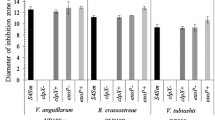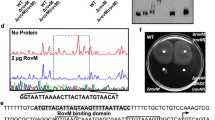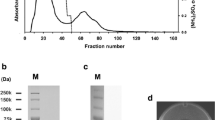Abstract
In this study, rpoS gene was identified from Edwardsiella tarda EIB202 and its functional role was analyzed by using an in-frame deletion mutant ∆rpoS and the complemental strain rpoS +. Compared with the wild type and rpoS +, ∆rpoS was impaired in terms of the ability to survive under oxidative stress and nutrient starvation, as well as the resistance to 50% serum of Scophthalmus maximus in 3 h, demonstrating essential roles of RpoS in stress adaptation. The rpoS mutant also displayed markedly increased chondroitinase activity and biofilm formation. Real-time polymerase chain reaction revealed that the expression level of quorum sensing autoinducer synthetase genes luxS and edwI was increased by 3.7- and 2.5-fold in the rpoS mutant strain. Those results suggested that rpoS might be involved in the negative or positive regulation of chondroitinase and biofilm formation, or quorum sensing networks in E. tarda, respectively. Although there were no obvious differences between the wild-type and the rpoS mutant in adherence of epithelioma papulosum cyprini (EPC) cell and in the lethality on fish model, rpoS deletion leads to the drastically reduced capacity for E. tarda to internalize in EPC cells, indicating that RpoS was, while not the main, the factor required for the virulence network of E. tarda.




Similar content being viewed by others
References
Castro N, Toranzo AE, Barja JL, Nunez S, Magarinos B (2006) Characterization of Edwardsiella tarda strains isolated from turbot, Psetta maxima (L.). J Fish Dis 29:541–547
Cochran WL, Suh SJ, McFeters GA, Stewart PS (2000) Role of RpoS and AlgT in Pseudomonas aeruginosa biofilm resistance to hydrogen peroxide and monochloramine. J Appl Microbiol 88:546–553
Cui Y, Chatterjee A, Yang H, Chatterjee AK (2008) Regulatory network controlling extracellular proteins in Erwinia carotovora subsp. carotovora: FlhDC, the master regulator of flagellar genes, activates rsmB regulatory RNA production by affecting gacA and hexA (lrhA) expression. J Bacteriol 190:4610–4623
Dennis JJ, Zylstra GJ (1998) Plasposons: modular self-cloning minitransposon derivatives for rapid genetic analysis of gram-negative bacterial genomes. Appl Environ Microbiol 64:2710–2715
Dong T, Coombes BK, Schellhorn HE (2009) Role of RpoS in virulence of Citrobacter rodentium. Infect Immun 77:501–507
Fang FC, Libby SJ, Buchmeier NA, Loewen PC, Switala J, Harwood J, Guiney DG (1992) The alternative factor KatF (RpoS) regulates Salmonella virulence. Proc Natl Acad Sci U S A 89:11978–11982
Fernandez AIG, Perez MJ, Rodriguez LA, Nieto TP (1995) Surface phenotypic characteristics and virulence of Spanish isolates of Aeromonas salmonicida after passage through fish. Appl Environ Microbiol 61:2010–2012
Frederick M (1995) Short protocols in molecular biology, 3rd edn. Wiley, New York
Gerhardt P, Murray RGE, Castilow RN, Nester EW, Wood WA, Krieg NR, Phillips GB (1981) Manual of methods for general bacteriology. American Society for Microbiology, Washington, DC
Han HJ, Kim DH, Lee DC, Kim SM, Park SI (2006) Pathogenicity of Edwardsiella tarda to olive flounder, Paralichthys olivaceus (Temminck & Schlegel). J Fish Dis 29:601–609
Hengge-Aronis R (1996) Regulation of gene expression during entry into stationary phase. In: Neidhardt FC, Curtiss III R, Ingraham JL, Lin ECC, Low KB, Magasanik B, Reznikoff WS, Riley M, Chaechter MS, Umbarger HE (eds) Escherichia coli and Salmonella: cellular and molecular biology, 2nd edn. American Society for Microbiology, Washington, DC, pp 1497–1512
Herman RL, Bullock GL (1986) Pathology caused by the bacterium Edwardsiella tarda in striped bass. Trans Am Fish Soc 115:232–235
Hiroshige M, Mochiyoshi N, Haruki S, Teruhiko T (2004) Puerperal intrauterine infection caused by Edwardsiella tarda. J Infect Chemother 9:341–343
Janda JM, Abbott SL (1993) Infections associated with the genus Edwardsiella: the role of Edwardsiella tarda in human disease. Clin Infect Dis 17:742–748
Janda JM, Abbott SL, Oshiro LS (1991) Penetration and replication of Edwardsiella spp. in Hep-2 cells. Infec Immun 59:154–161
Kazmierczak MJ, Wiedmann M, Boor KJ (2005) Alternative sigma factors and their roles in bacterial virulence. Microbiol Mol Biol Rev 69:527–554
Lange R, Fischer D, Hengge-Aronis R (1995) Identification of transcriptional start sites and the role of ppGpp in the expression of rpoS, the structural gene for the sigma S subunit of RNA polymerase in Escherichia coli. J Bacteriol 177:4676–4680
Liang W, Wang S, Yu F, Zhang L, Qi G, Liu Y, Gao S, Kan B (2003) Construction and evaluation of a safe, live, oral Vibrio cholerae vaccine candidate, IEM108. Infect Immun 71:5498–5504
Lima LC, Fernandes AA, CostaII AAP, Velasco FO, Leite RC, Hackett JL (2008) Isolation and characterization of Edwardsiella tarda from pacu Myleus micans. Arq Bras Med Vet Zootec 60:275–277
Lin YH, Kiyamoto C, Meighen EA (2002) Cloning, sequencing, and functional studies of the rpoS gene from Vibrio harveyi. Biochem Biophys Res Commun 293:456–462
Loewen PC, Hengge-Aronis R (1994) The role of the sigma factor sigma S (KatF) in bacterial global regulation. Annu Rev Microbiol 48:53–80
Mathew JA, Tan YP, Srinivasa Rao PS, Lim TM, Leung KY (2001) Edwardsiella tarda mutants defective in siderophore production, motility, serum resistance and catalase activity. Microbiol 147:449–457
Morales VM, Backman A, Bagdasarian M (1991) A series of wide-host-range low-copy-number vectors that allow direct screening for recombinants. Gene 97:39–47
Morohoshi M, Inaba T, Kado N, Kanai K, Ikeda T (2004) Identification of quorum-sensing signal molecules and the LuxRI homologs in fish pathogen Edwardsiella tarda. J Biosci Bioeng 98:274–281
Mukherjee A, Cui Y, Mu W, Liu Y, Ishihama A, Chatterjee AK (1998) RpoS (Sigma-S) controls expression of rsmA, a global regulator of secondary metabolites, harpin and extracellular proteins in Erwinia carotovora. J Bacteriol 180:3629–3634
Nucci C, Da Silveira WD, Da Silva Correa S, Nakazato G, Bando SY, Ribeiro MA, Pestana De Castro AF (2002) Microbiological comparative study of isolates of Edwardsiella tarda isolated in different countries from fish and humans. Vet Microbiol 89:29–39
Pressley ME, Phelan PE 3rd, Witten PE, Mellon MT, Kim CH (2005) Pathogenesis and inflammatory response to Edwardsiella tarda infection in the zebrafish. Dev Comp Immunol 29:501–513
Prouty AM, Gunn JS (2003) Comparative analysis of Salmonella enterica serovar typhimurium biofilm formation on gallstones and on glass. Infect Immun 71:7154–7158
Schuster M, Hawkins AC, Harwood CS, Greenberg EP (2004) The Pseudomonas aeruginosa RpoS regulon and its relationship to quorum sensing. Mol Microbiol 51:973–985
Shotts EB and Cooper RK (1992) Chondroitinase attenuated Edwardsiella ictaluri and a vaccine for prevention of enteric septicemia (ES) in fish. United States Patent 5536658
Small P, Blankenhorn D, Welty D, Zinser E, Slonczewski JL (1994) Acid and base resistance in Escherichia coli and Shigella flexneri: role of rpoS and growth pH. J Bacteriol 6:1729–1737
Srinivasa Rao PS, Lim TM, Leung KY (2001) Opsonized virulent Edwardsiella tarda strains are able to adhere to and survive and replicate within fish phagocytes but fail to stimulate reactive oxygen intermediates. Infect Immun 69:5689–5697
Stepanović S, Vuković D, Ježek P, Pavlović M, Švabic-Vlahović M (2001) Influence of dynamic conditions on biofilm formation by Staphylococci. Eur J Clin Microbiol Infect Dis 20:502–504
Tian Y, Wang QY, Liu Q, Ma Y, Cao XD, Zhang YX (2008) Role of RpoS in stress survival, synthesis of extracellular autoinducer 2, and virulence in Vibrio alginolyticus. Arch Microbiol 190:585–594
Vinogradov E, Nossova L, Perry MB, Kay WW (2005) Structural characterization of the O-polysaccharide antigen of Edwardsiella tarda MT 108. Carbohydr Res 345:85–90
Wakimoto N, Nishi J, Sheikh J, Nataro JP, Sarantuya J, Shita M, Manago K, Tokuda K, Yoshinaga M, Kawano Y (2004) Quantitive biofilm assay using a microtiter plate to screen for enteroaggregative Escherichia coli. Am J Trop Med Hyg 71:687–690
Waltman WD, Shotts EB, Hsu TC (1986) Biochemical characteristics of Edwardsiella ictaluri. Appl Environ Microbiol 51:101–104
Wang SY, Lauritz J, Jass J, Milton DL (2002) A ToxR homolog from Vibrio anguillarum serotype O1 regulates its own production, bile resistance, and biofilm formation. J Bacteriol 184:1630–1639
Xiao JF, Wang QY, Liu Q, Wang X, Liu H, Zhang YX (2009) Isolation and identification of fish pathogen Edwardsiella tarda from mariculture in China. Aquac Res 40:13–17
Zhang M, Sun K, Sun L (2008) Regulation of autoinducer 2 production and luxS expression in a pathogenic Edwardsiella tarda strain. Microbiol 154:2060–2069
Acknowledgments
This work was supported by grants from the Ministry of Agriculture of China (No. nyhyzx07-046), the National High Technology Research and Development Program of China (No. 2008AA092501) as well as by the Shanghai Leading Academic Discipline Project (No. B505) as well as by the National Special Fund for State Key Laboratory of Bioreactor Engineering (No. 2060204).
Author information
Authors and Affiliations
Corresponding authors
Rights and permissions
About this article
Cite this article
Xiao, J., Wang, Q., Liu, Q. et al. Characterization of Edwardsiella tarda rpoS: effect on serum resistance, chondroitinase activity, biofilm formation, and autoinducer synthetases expression. Appl Microbiol Biotechnol 83, 151–160 (2009). https://doi.org/10.1007/s00253-009-1924-9
Received:
Revised:
Accepted:
Published:
Issue Date:
DOI: https://doi.org/10.1007/s00253-009-1924-9




